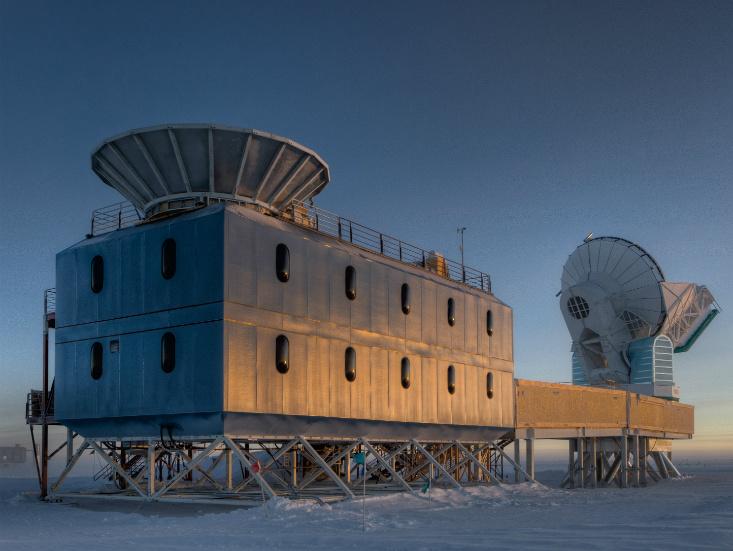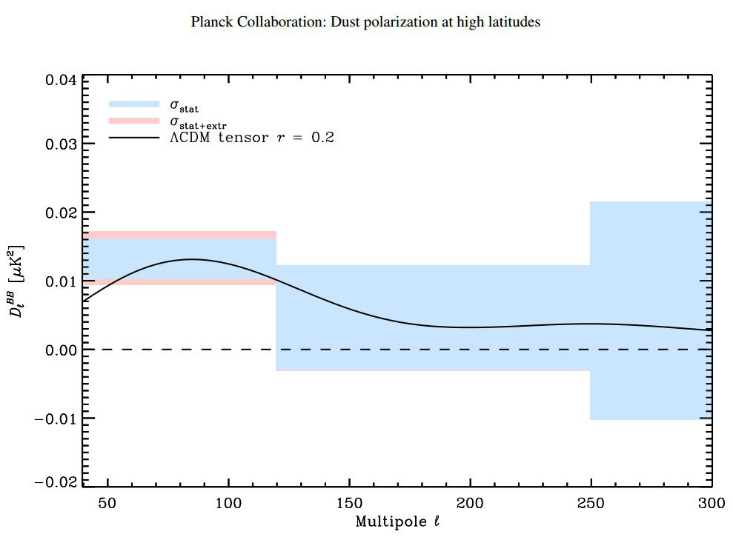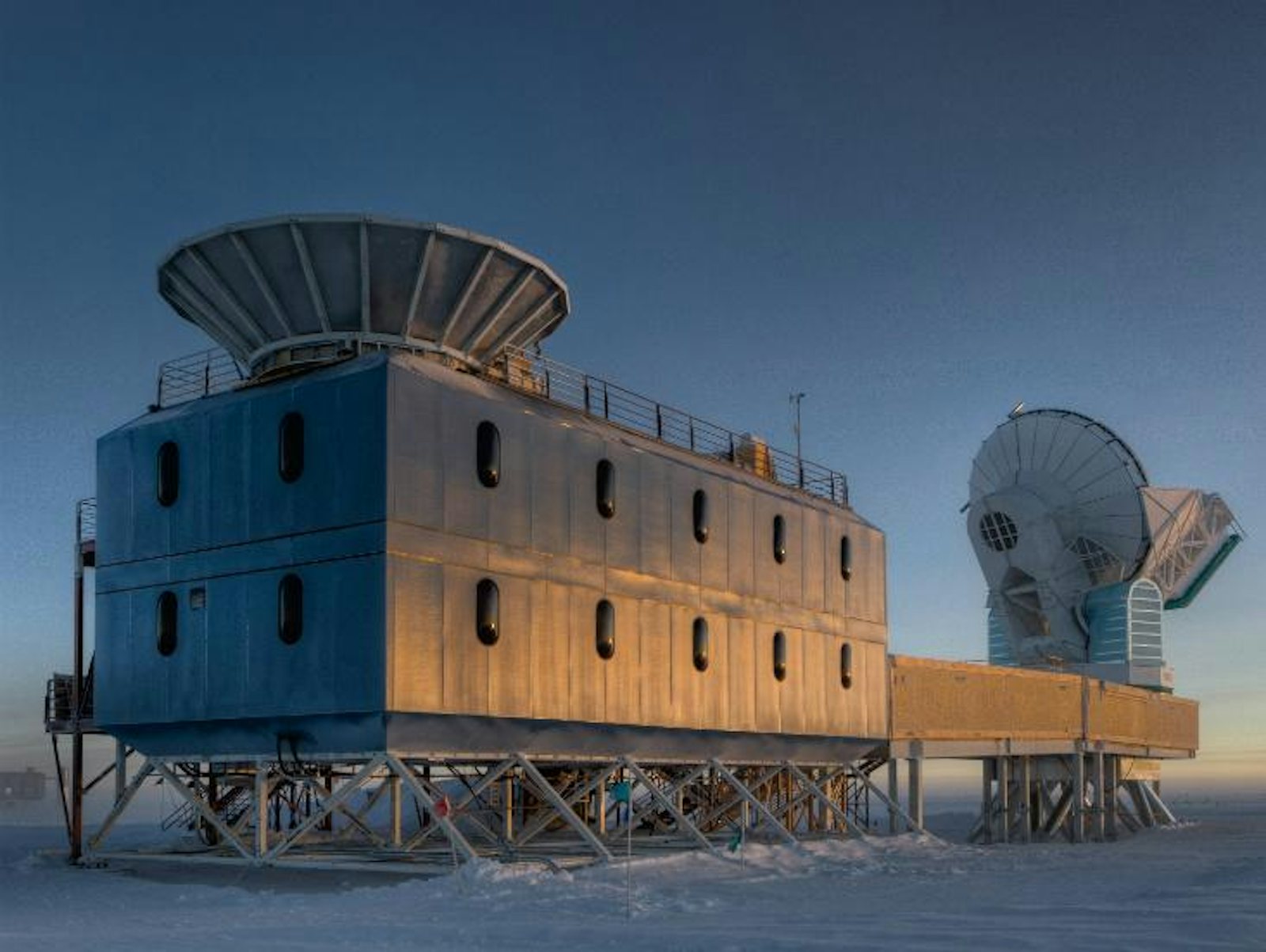
Science giveth, and science taketh away. What appeared earlier this year to be a long-sought glimpse of ancient ripples in spacetime now seems to have been schmutz in astronomers’ eyes.
In March, sky-gazers using a telescope at the South Pole called BICEP2 held a press conference announcing that they’d seen curlicues in the remnant glow from the Big Bang. The swirls, they said, were the imprints of gravitational waves produced nearly 14 billion years ago. These swirls would bolster the idea that the infant cosmos expanded faster than the speed of light during a brief growth spurt called inflation.
Researchers acknowledged that other telescopes would have to verify the signal for it to be trusted, but the news was greeted with jubilation, popped corks and talk of Nobel prizes. That giddiness (along with some caution that the work needed confirmation) was apparent in a roundup of quotes gathered by Nautilus the day after the result was announced at a Harvard press conference on March 17th. If confirmed, scientists said the find would “go down as one of the greatest discoveries in the history of science” and would be “bigger than [turning up] the Higgs boson.”
What a difference six months makes. Not long after the announcement, several groups pointed out that dust in our own galaxy could produce curlicues like those observed by BICEP2, throwing the gravitational wave interpretation into doubt. Now, observations made by Europe’s Planck satellite have borne out that possibility, suggesting that at least some—and maybe all—of the curlicue signal is caused by dust.

Why was Planck able to survey the galaxy’s dust and BICEP2 wasn’t? It comes down to the fact that the curlicues produced by dust brighten “more dramatically” at higher frequencies of radiation than those from gravitational waves, explains Natalie Wolchover at Quanta. So a mission that measures the sky at a range of frequencies, as Planck did from 2009 to 2013, is needed to more accurately estimate the amount of dust in the galaxy; BICEP2, in contrast, measured just one. “With a single frequency, you can’t be sure what’s causing that signal,” says Princeton physicist Paul Steinhardt, the subject of this issue’s Ingenious video Q&A.
The story is not yet over, since Planck and BICEP2 are now trying to merge their observations to get an even better handle on how much dust lies in BICEP2’s patch of sky. But judging from expert reactions quoted below, the initial waves of excitement about the result have all but crashed, leaving behind only a faint hope that not all of the curlicue signal is from dust.
Inflation Deflation:
Unfortunately it now does not look as if there is a realistic chance that what BICEP2 reported was anything more than a very precise measurement of dust.
—Sesh Nadathur in his blog Blank On The Map
The BICEP analysis gave a degree of confidence that I think people agree was based on an overoptimistic estimate of what the dust could have been, and not based on data.
—Planck team member Jo Dunkley in New Scientist
We can’t exclude that the entirety of our signal is from dust.
—BICEP2 team member Brian Keating in Quanta magazine
They should have been much more cautious in their initial presentation. They should not have claimed measuring a primordial B-mode because the uncertainty [in the amount of dust] is and was simply too large.
—Lyman Page in Quanta
BICEP2 did indeed observe the signal that they said they observed; but the smart money right now is betting that the signal didn’t come from the early universe.
—Sean Carroll in his blog Preposterous Universe
It doesn’t leave a lot of wiggle room…and it seems clear that at least the majority of the signal is caused by dust.
—Raphael Flauger in The New York Times
Our Galaxy is a rather grubby place to live. Even the windows are filthy.
—Peter Coles in his blog In the Dark
Definitely they detected something. The significance of that depends on what the interpretation is. If it’s dust, it has no cosmological significance whatsoever.
—Avi Loeb in Quanta
It looks like dust. Too bad—gravitational waves would be much more exciting.
—David Spergel in The Washington Post
Electromagnetic Rays of Hope:
What you can say for sure is that the original analysis was insufficient to say the signal is really there. It doesn’t mean for sure that they haven’t seen anything.
—Andrew Pontzen in The Guardian
The conclusion really is that we need to analyse the data together—BICEP and Planck—to get the right cosmological [versus] galactic [dust] signal. It’s really too early to say.
—Planck team member Cécile Renault on BBC News
I’m not going to say, “Goddamn it, there’s a cosmological signal there.” I’m not going to say there isn’t, either.
—BICEP2 team member Clement Pryke in Science
This is good news and bad news for gravitational wave detection. Good news is that there are regions of the sky with low dust polarization signal. The bad news is that BICEP2 did not look at one of these regions.
—David Spergel in The Washington Post
I can promise that we are approaching the analysis with a completely unbiased attitude. We are as eager as everyone else to see the uncertainties reduced here, whatever the final answer.
—BICEP2 team leader John Kovac in Quanta
Planck and BICEP2 have differing strengths and weaknesses and a joint analysis will benefit from considerable complementarity… Between them they may be able to identify an excess source of polarization over and above the foreground, so it is not impossible that there may a gravitational wave component may be isolated. That will be a tough job, however, and there’s by no means any guarantee that it will work.
—Peter Coles in his blog In the Dark
BICEP2 validated our whole experimental approach. We now have receivers operating at a different frequency that is much less sensitive to dust emission. We are deploying BICEP3, which will further improve the sensitivity in this channel. So basically if BICEP2 result doesn’t turn out to be a grand slam after all, we are still playing with the bases loaded.
—BICEP2 team member Chao-Lin Kuo in The Washington Post
It is amazing that a precise measurement of the cosmos can be made, discussed in fullness, and refuted by another measurement in such a short amount of time. It is testament to a healthy field.
—Lyman Page in The New York Times
Maggie McKee is a freelance science writer in Boston.


























